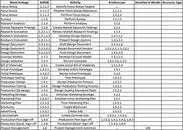Dependencies are the relationships among tasks which determine the order in which activities need to be performed. There are four (4) types of dependency relationships.
Types of dependencies
| Finish to Start | Predecessor must finish before Successor can start. [Land must be purchased before road building can start] | |
| Start to Start | Predecessor must start before Successor can start. [Road excavating must start before Asphalt can be laid] | |
| Finish to Finish | Predecessor must finish before Successor can finish. [Laying Asphalt must be complete before line painting can be completed] | |
| Start to Finish |  | Predecessor must start before Successor can finish. [Road excavating must start before line painting can be completed] |
Dependencies are the relationships of the preceding tasks to the succeeding tasks. Tasks may have multiple preceding tasks and multiple succeeding tasks. The most common dependency relationship is a finish-to-start relationship. Task P (predecessor) must be finished before task S (successor) can start. The least common relationship is the start-to-finish relationship. Project Insight, project management software, supports all four dependency relationships.
Product Development Activity List

The chart above shows how a Product Development Activity List may look after the project team determines the task relationships. In our example, only finish-to-start relationships were used.
It is always easier to arrange all tasks in terms of a finish-to-start relationship and an ‘as soon as possible’ constraint. This dependency type is the easiest relationship for others to understand and will usually result in a longer than normal schedule. This gives the schedule more ‘slack.’ You may then utilize the other relationships as ways to shrink the duration of the overall schedule.


Comments are closed